
The best online fitness resource you'll ever need. We filter out the BS to ensure you meet your health and fitness goals!

The best online fitness resource you'll ever need. We filter out the BS to ensure you meet your health and fitness goals!
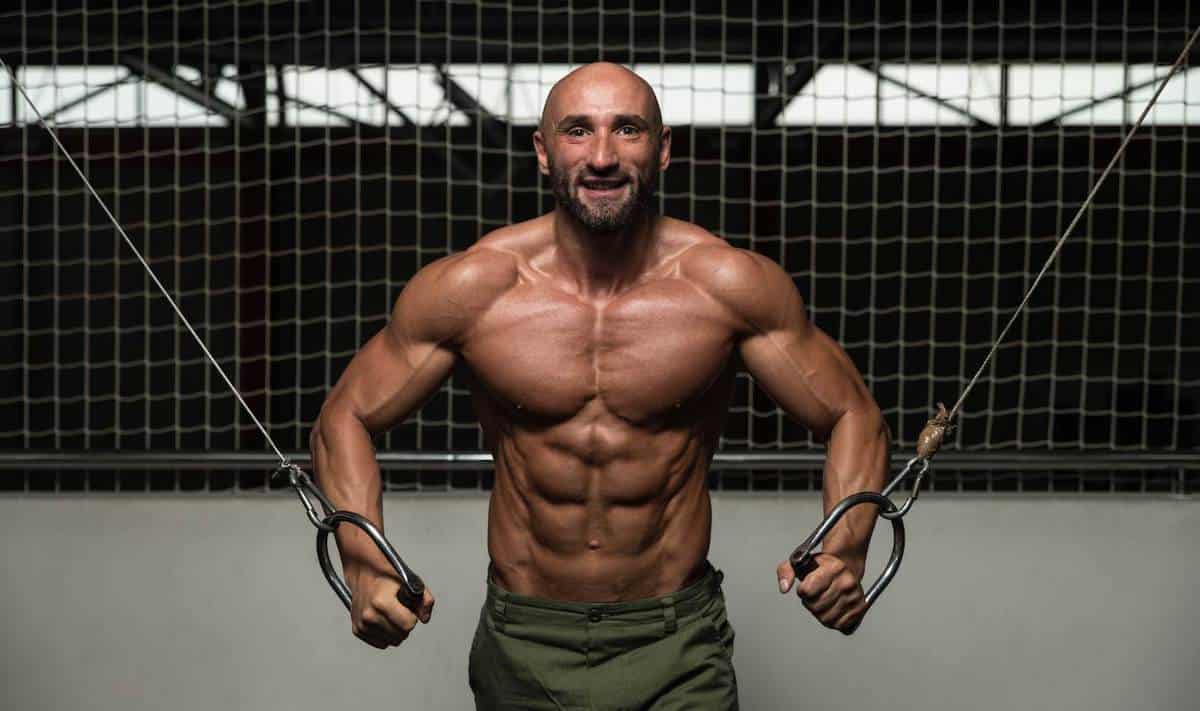
If the only gym equipment you have available is a cable machine, consider yourself lucky. Cables are the most versatile and biomechanically effective resistance training method you can use, and we’ve constructed the ultimate cable machine workout routine you can do on any size selectorized cable machine.
Whether you’ve got one of the larger, multi-station cable machines like the Signature Series Multi-Jungle from LifeFitness, their 12-Stack Multi-Station, or the space efficient Dual Cable Cross from FreeMotion, you can build and tone your body without sacrifice.
Jump to the program now!
Alternatively, you can download the free PDF version of the program using the link below:
| Program style | Resistance training with cable machines |
| Workout duration | 1-2 hours |
| Scheduling | 3 or 6 days a week |
| Goal | Build muscle |
| Level | Beginners to advanced |
| Target Gender | Male and Female |
Cable machines are versatile.
There’s almost no exercise you can’t do on one. And fortunately, some of the best-of-the-best exercises for building, shaping, and toning muscle are best done on one.
Cable machines are also biomechanically effective.
Why is that?
Barbells, dumbbells, kettlebells… they all depend on you lining yourself up between them and the floor, because they depend on gravity.
Not so with cables!
Selectorized cable machines let you position resistance in line with where you are, not gravity. No need to contort yourself to line up between the weight and gravity. Just change the pulley or adjustable arm height and you’re ready to rock.
And, well, they’re convenient.
No loading and unloading of plates, or hoisting dumbbells off the rack. The only fiddle-factor you’ve got is changing handles, weight pin, and cable height.
Finally, cable machines are available.
They’re everywhere. Many hotel fitness centers have commercial grade multi-station cable machines.
Nearly all commercial gyms have at least one, and often a variety of them… with and without benches and row attachments, pull-up bars, and so forth.
If I were building a home gym, the first piece of equipment I’d buy would be a heavy-duty dual-arm cable machine.
I’d add an adjustable bench, a couple of dumbbells, a small variety of handles and attachable wrist/ankle straps, and I’d be ready to go.
I’m going to show you how you can apply this cable machine workout routine as a 3-Day Push Pull Leg (PPL) format, an Upper-Lower Split, or a full body routine.
No matter what your schedule, or your preference, you can use this workout as your only routine, or supplement the one you have now.
This routine is very close to the one I follow all the time. I’m currently following a 3-Day PPL routine using mostly cables. However, when I’m traveling and my schedule is upside down, it’s super-easy to adapt the routine into an Upper-Lower Split or whole body workout if that fits the time I’ve got available to work out.
For best results, you should pick the routine that works for your schedule and goals, and follow it religiously for 12 weeks. That will allow you to honestly assess what went well and what didn’t before you go hopping around to another version.
I’ve been training seriously for over 40 years, so–pardon me for saying this–I can experiment and iterate and still get by with it.
In general though, I find the PPL gives me the best load:recovery ratio for my age, fitness level, and experience base.
You can expect to be surprised by how much you can do on a good cable machine without sacrificing a thing in workout quality.
I do almost 100% of my exercises with a cable machine out of preference, because I can target select muscles and kill ‘em good.
Today for instance, I did everything except trap bar RDLs and leg curls on a cable station. (It is possible to even do leg curls on a single cable machine. Some set-up required.)
You can also expect to be better able to target specific muscles, or regions of a target muscle, using cables, depending on where you position the pulley, and your choice of grip.
Besides a good quality cable machine, you’ll want the following equipment to get the most out of the routine.
With the exception of Velcro wrist straps with carabiners, most cable machines ship with these attachments already.
Some exercises are best done on a cable machine. They target their intended body part better than any other gym implement. Here’s my short list.
The cable machine loads the deltoid from beginning to end. Dumbbells’ by contrast are easier to move at the bottom with peak resistance at the top.
Not so with cables.
The cable exerts equivalent tension throughout, and although we could get geeky with the trigonomics and show that there is some variation, there’s not going to be much argument about which tool will build boulder shoulders best.
Bro Tip: Use adjustable wrist straps with a carabiner to take your grip out of the equation. We’re training delts here, not grip. You’ll find that you’re able to concentrate on the delts more without concern about holding a handle.
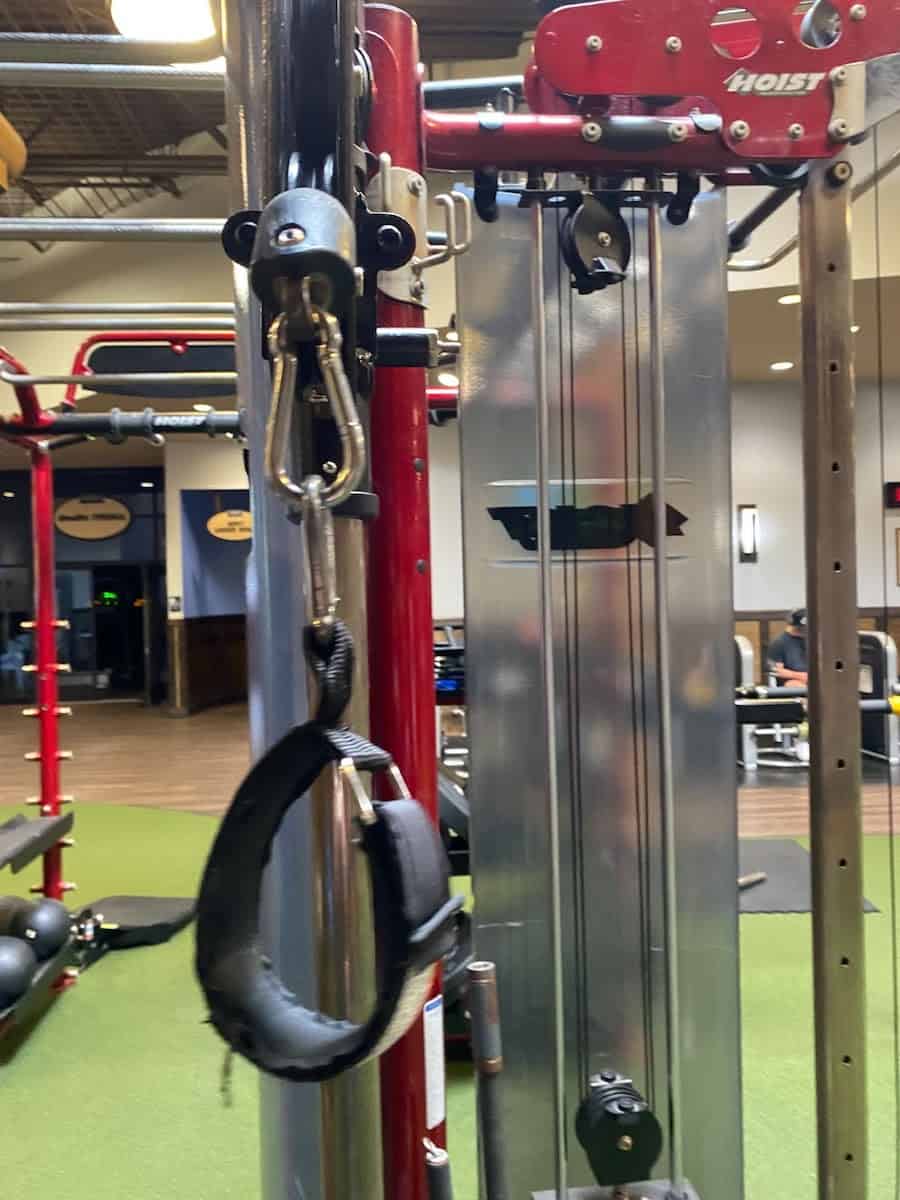
I got my straps from GoFit and use them on wrists and ankles. I also like the Hypertrophy Coach cuffs. HC’s are wider and although they have no carabiner of their own, cable machines always do.
Like cable laterals, cable pushdowns keep the tension on the triceps throughout the motion and there is no place for the tris to hide: bottom, top, or mid-range.
You’ve got your choice of handle and grip, so whether you opt for a bar attachment, rope, handles, or use wrist straps to take grip strength out of the equation, triceps extensions on the cable machine reign supreme for jacking up the horseshoes.
If you’re one of those who likes the rope for triceps cable pushdowns, you’ve got to check out this tip I picked up from Tom Purvis.
Use cable handles with long straps. Angle the handles top to bottom so that when you grip them, the heels of your hands are pointed toward the floor.
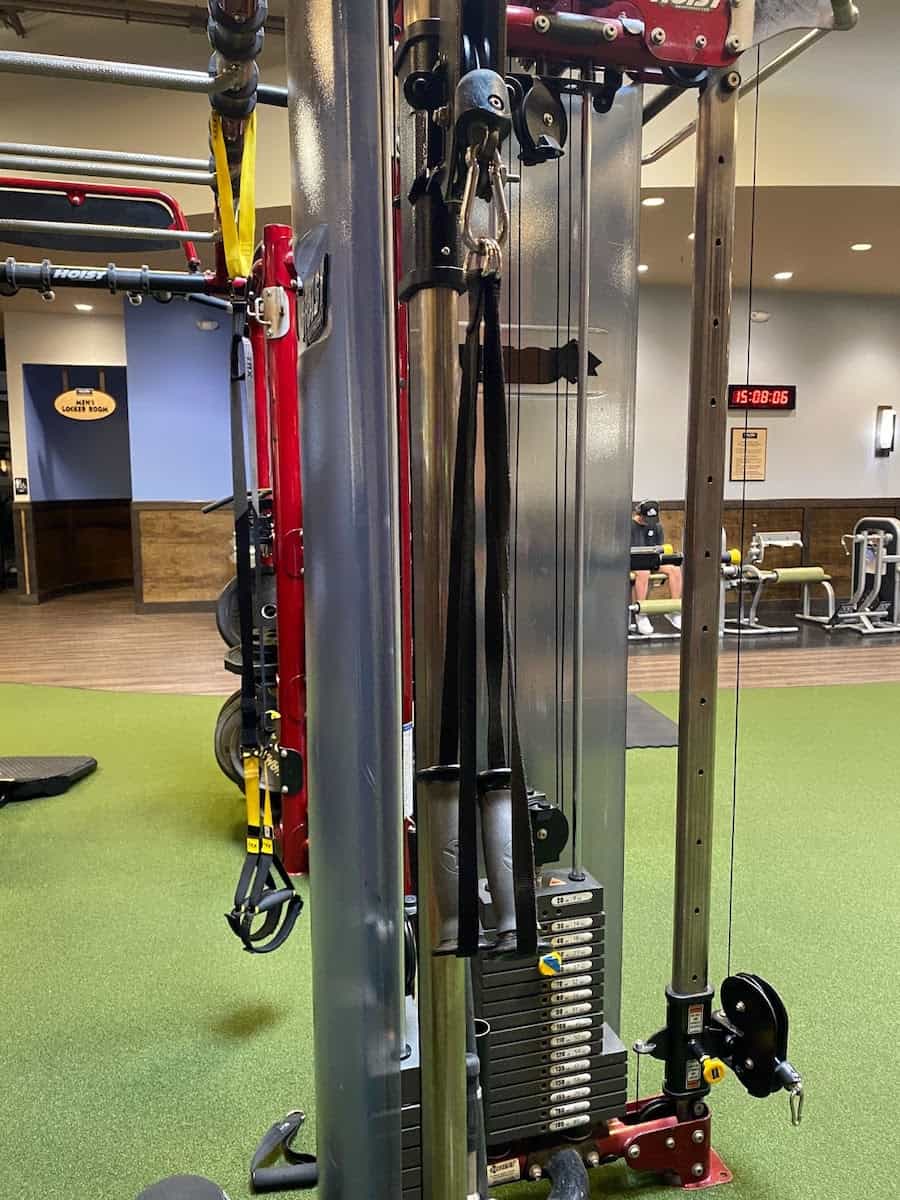
When you push down, the handles won’t load your wrists the way the rope will. Your wrists won’t be your limiter, and you’ll also get a greater range of motion.
You can also opt for the more traditional straight bar or EZ Curl bar attachment for your arm extensions. It really is a matter of preference; whichever attachment allows you to load up the triceps the most while using great form.
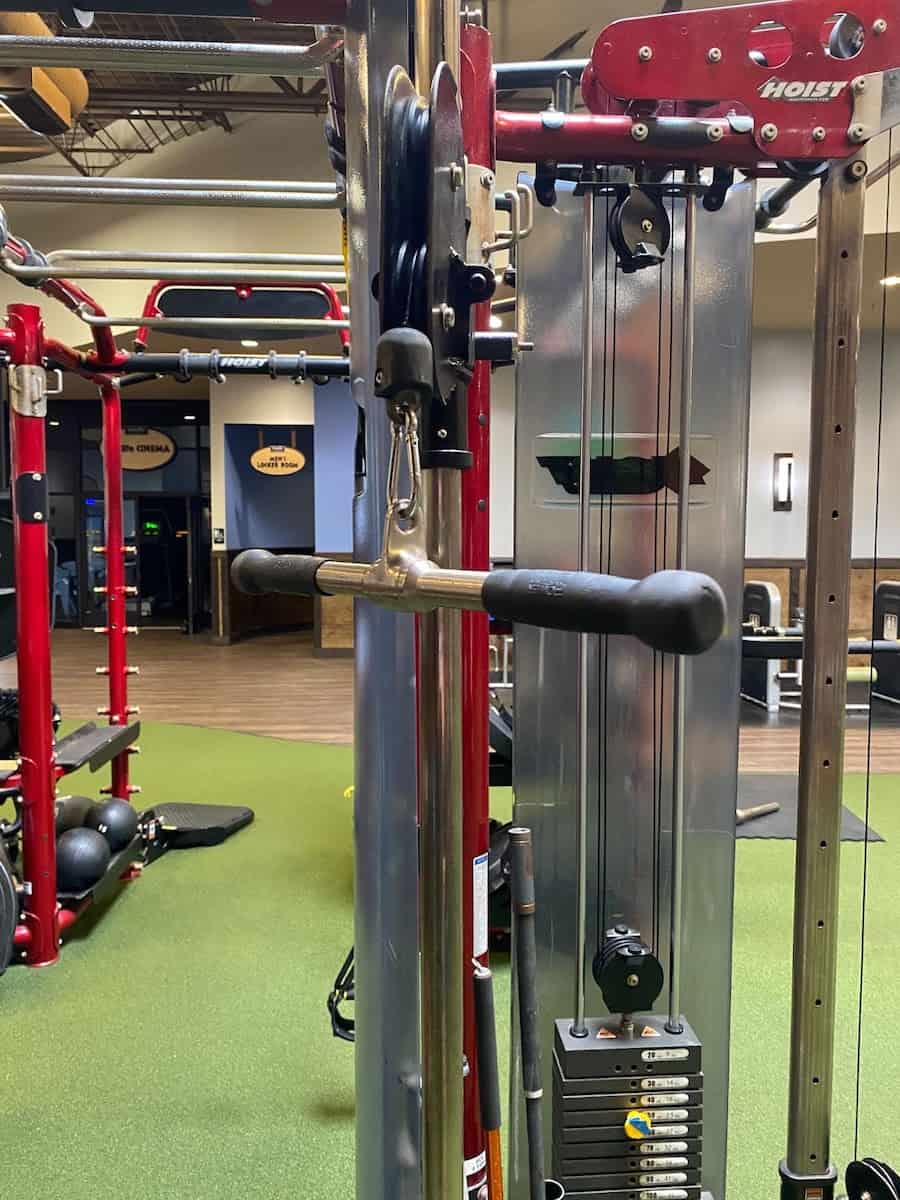
Credit the late Doug Brignole with these. In this lifter’s opinion, the cable assisted sissy is the least appreciated, most under-utilized quad gasser of all time.
They’re a little like Pendulum Squats, so if your gym isn’t lucky enough to have a Pendulum Squat machine, try these out.
The exercise’s pattern of motion is like a pendulum squat (and if I had a pendulum squat machine, I’d opt for it…but I don’t).
The cables are set low using either handles (if you’ve got a dual arm cable machine), or an EZ Curl attachment. Back away from the machine and with upper body tense and fixed, lean back and aim your hips toward the machine.
Here’s my set-up for Cable Sissy Squats. I like the dual axis cable machine for this exercise. FreeMotion’s Dual Cable station works great for me.
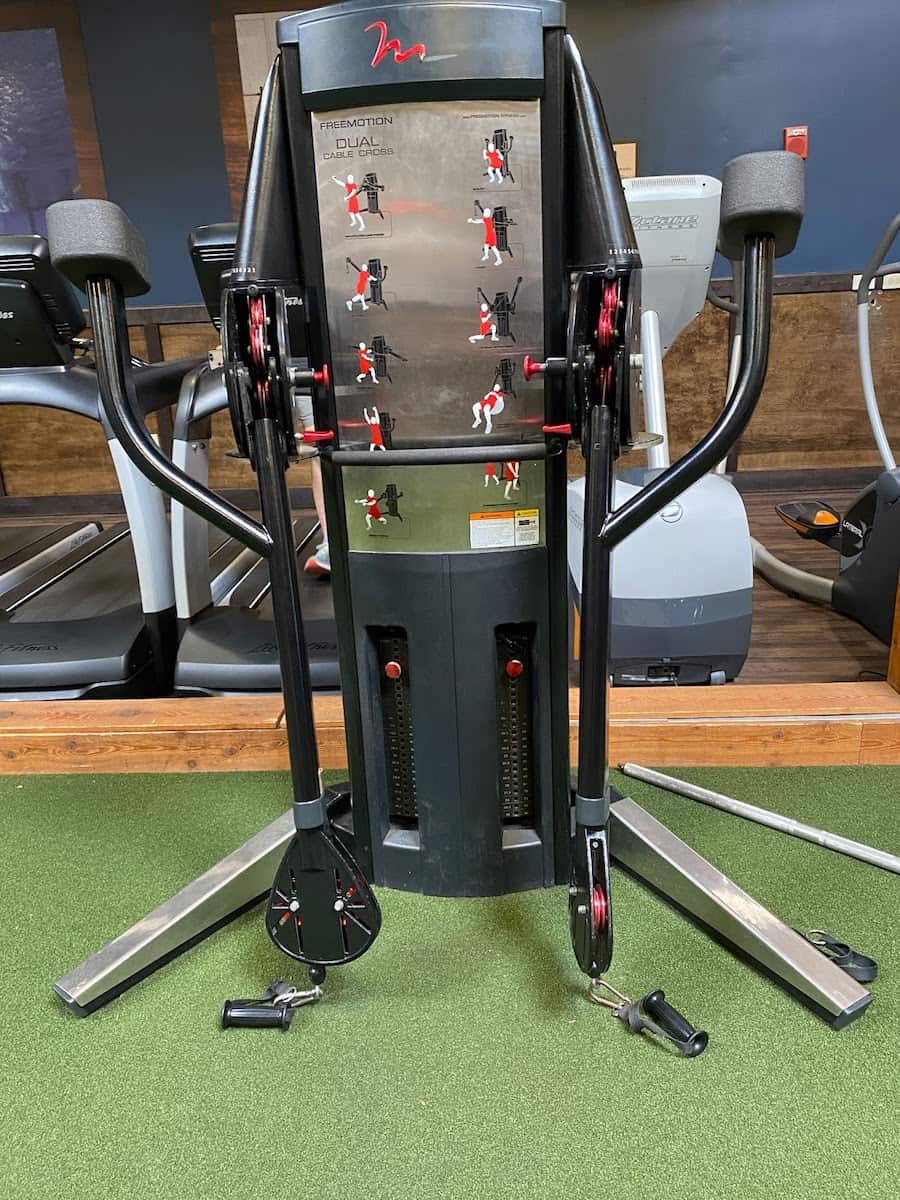
Set the cable arms as low as they’ll go and shoulder width. I prefer the short loop handles. I’ve tried long loops but short seem to work better…not exactly sure why.
Step back two or three steps…whatever it takes to get the cable you’ll need to do the exercise. It’s important to lean back so that your butt is moving toward the machine.
You can use a slant board or heel wedges if you like to put your feet in a more comfortable position.
The feeling is squatting “into” the machine and pulling back. They’ll feel a lot like a leg extension, only a whole lot more challenging.
I did these today in preparation for writing this piece and was again reminded of what a kick-a$$ exercise this is.
Pair these in a superset with regular cable squats and be prepared to use crutches the next day.
As I’ve journeyed through various workout regimens, I’ve discovered the profound adaptability of this cable machines when structured into three distinct formats:
You’re probably familiar with the PPL format. It divides the body into logical subdivisions (typically one per day = 3 days), allowing intense concentration on a couple of muscle groups per workout while considering recovery needs on days following.
| Day | Split |
|---|---|
| Push | Chest, Anterior shoulders, Triceps |
| Pull | Back (Lats, Trapezius, Posterior shoulders), Biceps |
| Legs | Quads, Hams, Lower legs, Glutes (and some lower back stuff) |
This 3-Day PPL can be done in consecutive days to make it a 6-Day routine, or, you can insert your rest days for a 3-day-per-week routine.
The Push Days are divided into chest and shoulder days. Here, Pull Days split focus between lats, middle, and lower trapezius muscles with biceps worked each day. Leg Days divide up quad, hamstring, glute, and lower leg work into two days, spreading out tried-and-true muscle building movements to prevent overtraining.
Pay attention to how each exercise feels to personally evaluate the piece of equipment that seems to work best for you. Don’t switch back and forth – give each one an honest try and critically assess your results.
Here’s how you might schedule a 3-Day PPL program:
| Weekday | Day | Split |
|---|---|---|
| Sunday | Push | Chest, Anterior shoulders, Triceps |
| Monday | Rest | |
| Tuesday | Pull | Back (Lats, Trapezius, Posterior shoulders), Biceps |
| Wednesday | Rest | |
| Thursday | Legs | Quads, Hams, Lower legs, Glutes (and some lower back stuff) |
| Friday | Rest | |
| Saturday | Rest |
And here it is as a 6 day PPL program, which I think is too much. But if you’re up for it, eating and sleeping enough and aren’t over 50, knock yourself out. (6 days is far too much for individuals in middle age. It’s no disrespect. I’m 63 myself; and no way would I work out 6 days a week).
| Weekday | Day | Split |
|---|---|---|
| Sunday | Push | Chest, Anterior shoulders, Triceps |
| Monday | Pull | Back (Lats, Trapezius, Posterior shoulders), Biceps |
| Tuesday | Legs | Quads, Hams, Lower legs, Glutes (and some lower back stuff) |
| Wednesday | Push | Chest, Anterior shoulders, Triceps |
| Thursday | Pull | Back (Lats, Trapezius, Posterior shoulders) |
| Friday | Legs | Quads, Hams, Lower legs, Glutes (and some lower back stuff) |
| Saturday | Rest |
Next is the cable routine formatted as an Upper-Lower Split, done twice per week. You can do it 4 times a week also, 2x Upper and 2x Lower if you’re recovering sufficiently between workouts.
It would look something like this:
| Weekday | Day | Split |
|---|---|---|
| Sunday | Upper | Chest, Delts, Arms, Back, Abs |
| Monday | Lower | Quads, Glutes, Abductors/Adductors, Hamstrings, Calves |
| Tuesday | Rest | |
| Wednesday | Upper | Chest, Delts, Arms, Back, Abs |
| Thursday | Lower | Quads, Glutes, Abductors/Adductors, Hamstrings, Calves |
| Friday | Rest | |
| Saturday | Rest |
Or, you can do the Upper-Lower in a 7 day rotation but it’s not recommended. Way too much work if you’re training with any intensity at all. If you did choose to do it as a 7-day (6-day and a rest day), you’ll need to monitor your recovery and Reps In Reserve to prevent overtraining. Aim for a 1 to 2 RIR.
You’ll also require at least 9 hours of sleep a night and your nutrition will need to be spot on.
Don’t to the Upper-Lower as a 6-day for more than 6 weeks at a stretch. If you’re making progress, that’s fine.
If you’re really pushing yourself in the gym, chances are you’ll not be able to keep up a 6-day/week routine for very long. But here it is if you’d like to give it a shot.
| Weekday | Day | Split |
|---|---|---|
| Sunday | Upper | Chest, Delts, Arms, Back, Abs |
| Monday | Lower | Quads, Glutes, Abductors/Adductors, Hamstrings, Calves |
| Tuesday | Upper | Chest, Delts, Arms, Back, Abs |
| Wednesday | Lower | Quads, Glutes, Abductors/Adductors, Hamstrings, Calves |
| Thursday | Upper | Chest, Delts, Arms, Back, Abs |
| Friday | Lower | Quads, Glutes, Abductors/Adductors, Hamstrings, Calves |
| Saturday | Rest |
Last, the Cable Machine Routine works as a Full Body routine. It includes a fast-casual menuing format, where you pick from body part exercises as you like. Use good training logic for your selections.
It can be done any number of days per week. More than 5 days per week isn’t recommended: not enough recovery time. The sweet spot would be 3 to 4 times weekly.
Something like this:
| Weekday | Split |
|---|---|
| Sunday | Full Body Workout 1 |
| Monday | Rest |
| Tuesday | Full Body Workout 2 |
| Wednesday | Rest |
| Thursday | Full Body Workout 3 |
| Friday | Rest |
| Saturday | Full Body Workout 4 |
And since it’s a full body format, you have to train each body part every workout. Use the menuing below to select your exercise for the given body part.
| Body Part | Daily Exercise Selection |
|---|---|
| Chest (Pick 1) | – Chest Press – High-Low Flyes – Low-High Flyes |
| Shoulders (Pick 1) | – Side laterals – Front raises – Reverse Flyes |
| Arms (Pick 1 OR Superset) | – Triceps Extensions (Pushdowns) – Bicep Curls (Palms Up or Hammer grip) |
| Back (Pick 2) | – Cable Pull-Downs, Kneeling or Seated – Cable Rows, Seated 2-arm or Kneeling 1-arm – Motorcycle Rows |
| Legs (Pick 1 OR Superset) | – Cable Sissy Squats – Cable Squats |
| Glutes (Pick 1) | – Hip Extensions – Hip Abductions |
| Calves | Calf Raises, single or both leg |
| Abs | Cable Crunches |
Regardless of which format you decide to roll with, results are a guarantee. That’s the beauty of the cable machine.
Whether you’re grinding through the 3-Day PPL, feeling the burn with the Upper-Lower Split, or going all out with the Full Body format, gains are on the horizon. It’s not about which format is ‘better’ – it’s about consistency, effort, and pushing those limits.
I’ve seen folks debate endlessly about the ‘best’ workout structure. But let me tell you, from one lifter to another, it’s not the format that makes the difference; it’s the fire you bring to each session.
So, pick a format, give it your all, and watch those muscles pop.
Because with the cable machine in your corner, every rep, every set, every sweat-drenched session is a step closer to those goals. And trust me, they’re within reach.
In the next section, I’ve developed specific routines for each format. Pick the version that’s right for you. Think about your everyday schedule–work, school, family commitments, and so on–and how many days you’ll need to recover, so that every workout is productive and energizing.
| Exercise | Set 1 | Set 2 | Set 3 | Set 4 |
|---|---|---|---|---|
| Chest Press | 15-20 | 10-12 | 8-10 | 6-8 |
| Cable Flyes, High to Low | 15-20 | 10-12 | 8-10 | 8-10 |
| Cable Flyes, Low to High | 15-20 | 10-12 | 8-10 | 8-10 |
| Lateral Raises | 15-20 | 10-12 | 8-10 | 8-10 |
| Triceps Extensions | 15-20 | 10-12 | 8-10 | 8-10 |
| Exercise | Set 1 | Set 2 | Set 3 | Set 4 |
|---|---|---|---|---|
| Cable Curls, Hammer or Palms-Up Grip | 15-20 | 10-12 | 8-10 | 8-10 |
| Kneeling Cable Pull-Downs | 15-20 | 10-12 | 8-10 | 8-10 |
| Cable Rows, Seated 2-arm or Kneeling 1-arm | 10-12 | 10-12 | 10-12 | 10-12 |
| Reverse Flyes | 15-20 | 10-12 | 8-10 | 8-10 |
| Motorcycle Rows | 15-20 | 10-12 | 8-10 | 8-10 |
| Cable Crunches | 15-20 | 15-20 | 15-20 | 15-20 |
| Exercise | Set 1 | Set 2 | Set 3 | Set 4 |
|---|---|---|---|---|
| Cable Sissy Squats | 15-20 | 10-12 | 8-10 | 6-8 |
| Cable Squats | 15-20 | 15-20 | 15-20 | 15-20 |
| Hip Extensions | 15-20 | 10-12 | 8-10 | 8-10 |
| Hip Abductions | 15-20 | 10-12 | 8-10 | 8-10 |
| Leg Curls | 15-20 | 10-15 | 10-12 | 8-10 |
| Standing Calf Raises | 15-20 | 15-20 | 15-20 | 15-20 |
| Exercise | Set 1 | Set 2 | Set 3 |
|---|---|---|---|
| Chest Press | 15-20 | 10-12 | 8-10 |
| Cable Flyes, High to Low | 15-20 | 10-12 | 8-10 |
| Cable Flyes, Low to High | 15-20 | 10-12 | 8-10 |
| Lateral Raises | 15-20 | 10-12 | 8-10 |
| Triceps Extensions | 15-20 | 10-12 | 8-10 |
| Cable Curls, Hammer or Palms-Up Grip | 15-20 | 10-12 | 8-10 |
| Kneeling Cable Pull-Downs | 15-20 | 10-12 | 8-10 |
| Cable Rows, Seated 2-arm or Kneeling 1-arm | 10-12 | 10-12 | 10-12 |
| Motorcycle Rows | 15-20 | 10-12 | 8-10 |
| Cable Crunches | 15-20 | 15-20 | 15-20 |
| Exercise | Set 1 | Set 2 | Set 3 | Set 4 |
|---|---|---|---|---|
| Cable Sissy Squats | 15-20 | 10-12 | 8-10 | 6-8 |
| Cable Squats | 15-20 | 15-20 | 15-20 | 15-20 |
| Hip Extensions | 15-20 | 10-12 | 8-10 | 8-10 |
| Hip Abductions | 15-20 | 10-12 | 8-10 | 8-10 |
| Leg Curls | 15-20 | 10-15 | 10-12 | 8-10 |
| Standing Calf Raises | 15-20 | 15-20 | 15-20 | 15-20 |
| Exercise | Set 1 | Set 2 | Set 3 |
|---|---|---|---|
| Chest Press | 15-20 | 10-12 | 8-10 |
| Cable Flyes, High to Low | 15-20 | 10-12 | 8-10 |
| Cable Flyes, Low to High | 15-20 | 10-12 | 8-10 |
| Lateral Raises | 15-20 | 10-12 | 8-10 |
| Triceps Extensions | 15-20 | 10-12 | 8-10 |
| Cable Curls, Hammer or Palms-Up Grip | 15-20 | 10-12 | 8-10 |
| Kneeling Cable Pull-Downs | 15-20 | 10-12 | 8-10 |
| Cable Rows, Seated 2-arm or Kneeling 1-arm | 10-12 | 10-12 | 10-12 |
| Motorcycle Rows | 15-20 | 10-12 | 8-10 |
| Cable Crunches | 15-20 | 15-20 | 15-20 |
| Exercise | Set 1 | Set 2 | Set 3 | Set 4 |
|---|---|---|---|---|
| Cable Sissy Squats | 15-20 | 10-12 | 8-10 | 6-8 |
| Cable Squats | 15-20 | 15-20 | 15-20 | 15-20 |
| Hip Extensions | 15-20 | 10-12 | 8-10 | 8-10 |
| Hip Abductions | 15-20 | 10-12 | 8-10 | 8-10 |
| Leg Curls | 15-20 | 10-15 | 10-12 | 8-10 |
| Standing Calf Raises | 15-20 | 15-20 | 15-20 | 15-20 |
| Exercise | Set 1 | Set 2 | Set 3 | Set 4 |
|---|---|---|---|---|
| Chest Press | 15-20 | 10-12 | 8-10 | 6-8 |
| Lateral Raises | 15-20 | 10-12 | 8-10 | 8-10 |
| Tricep Extensions (Pushdowns) | 15-20 | 10-12 | 8-10 | 8-10 |
| Cable Pull-Downs, Kneeling or Seated | 15-20 | 10-12 | 8-10 | 8-10 |
| Cable Rows, Seated 2-arm or Kneeling 1-arm | 10-12 | 10-12 | 10-12 | 10-12 |
| Cable Sissy Squats | 15-20 | 10-12 | 8-10 | 6-8 |
| Hip Extensions | 15-20 | 10-12 | 8-10 | 8-10 |
| Standing Calf Raises | 15-20 | 15-20 | 15-20 | 15-20 |
| Cable Crunches | 15-20 | 15-20 | 15-20 | 15-20 |
| Exercise | Set 1 | Set 2 | Set 3 | Set 4 |
|---|---|---|---|---|
| Chest Flyes, High to Low | 15-20 | 10-12 | 8-10 | 8-10 |
| Front Raises | 15-20 | 10-12 | 8-10 | 8-10 |
| Cable Curls, Hammer or Palms-Up Grip | 15-20 | 10-12 | 8-10 | 8-10 |
| Cable Pull-Downs, Kneeling or Seated | 15-20 | 10-12 | 8-10 | 8-10 |
| Motorcycle Rows | 15-20 | 10-12 | 8-10 | 8-10 |
| Cable Sissy Squats | 15-20 | 10-12 | 8-10 | 6-8 |
| Hip Abductions | 15-20 | 10-12 | 8-10 | 8-10 |
| Standing Calf Raises | 15-20 | 15-20 | 15-20 | 15-20 |
| Cable Crunches | 15-20 | 15-20 | 15-20 | 15-20 |
| Exercise | Set 1 | Set 2 | Set 3 | Set 4 |
|---|---|---|---|---|
| Chest Flyes, Low to High | 15-20 | 10-12 | 8-10 | 8-10 |
| Reverse Flyes | 15-20 | 10-12 | 8-10 | 8-10 |
| Triceps Extensions super set with Cable Curls, Hammer or Palms-Up Grip | 15-20 | 10-12 | 8-10 | 8-10 |
| Motorcycle Rows | 15-20 | 10-12 | 8-10 | 8-10 |
| Cable Rows, Seated 2-arm or Kneeling 1-arm | 10-12 | 10-12 | 10-12 | 10-12 |
| Cable Sissy Squats | 15-20 | 10-12 | 8-10 | 6-8 |
| Hip Extensions | 15-20 | 10-12 | 8-10 | 8-10 |
| Standing Calf Raises | 15-20 | 15-20 | 15-20 | 15-20 |
| Cable Crunches | 15-20 | 15-20 | 15-20 | 15-20 |
All the basic rules of resistance training should be observed for the cable machine program as for any other resistance training routine. Some things just work all the time.
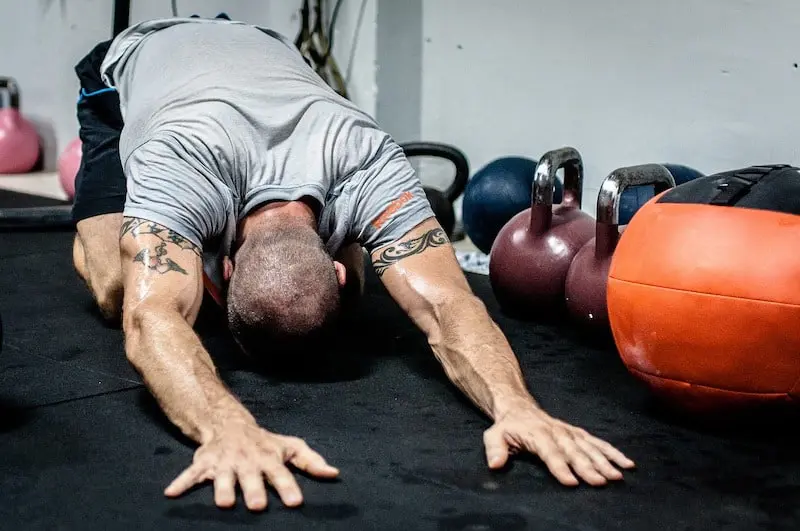
Warm up before your workout to prevent injury and practice the movements. Warm-ups are important for anyone and even more crucial for older adults. If you’re a newcomer to the gym but a veteran in another sport, you’ll already understand the value of a good warm-up.
The warm-ups included in this workout program are composed of very light sets of the movements you’ll be doing during the workout, an application of the SAID Principle (Specific Adaptation to Imposed Demands).
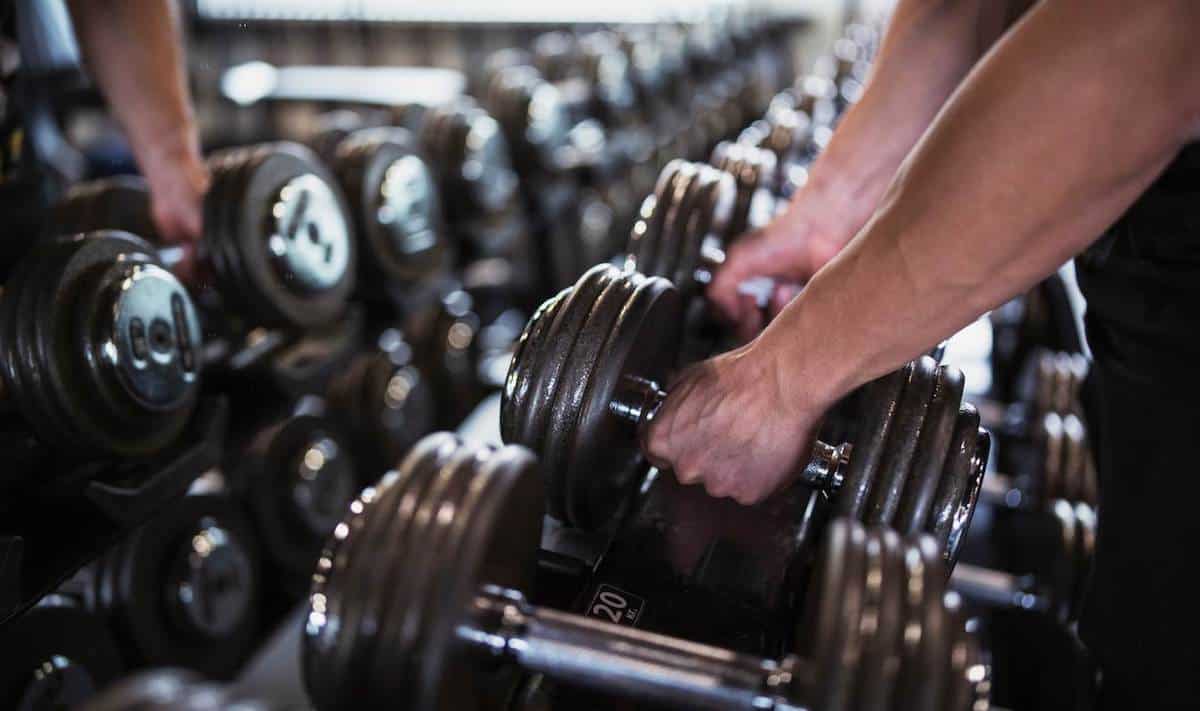
As with all resistance training routines, progressive overload always applies.
It’s very simple: select the weight you can perform for the specified number of repetitions. Once you can comfortably perform the set without mechanical failure on the last rep, raise the weight so that you’re back down to the lower end of the rep range.
Example: For a set of 8 to 12, once you can do the 12th rep with good form and maybe the 13th, raise the weight so that rep #8 is the most you can do with good form. Continue using that weight until you can again do it well for 12 reps.
Repeat that cycle.
Buy a composition notebook and use it to write down your sets, reps, and weights.
Progressive overload is one of the unarguable tenets of resistance training, regardless whether you’re training for shape, size, or strength. It always works.
Remember that perfect form is the goal for every rep. The saying goes, “It’s not counting your reps, it’s making your reps count”.
Best application for this program is 1 or 2 RIR for the first set or two, then no reps in reserve for the last sets of an exercise.
Set your weights so that the last rep of every set really is the last one you can do with good form.
For the last set or two of each exercise, the last couple of reps should be crazy hard with good form. The weight will be moving very slowly but you’ll be working hard to get it to move at all.
Raise the weight if you can do the last rep of any set with complete ease.
Use a methodical, rhythmic, pumping motion.
No fast concentric-slow eccentric, etc. Your eccentric phases should be slow and controlled…just not timed.
Do not use momentum. Focus on moving the body part you’re working and not any others.
Aim for 7 to 8 hours of quality sleep nightly. This is when you recover and your hard work will have a chance to pay off.

Rest a minute or 2 between warm-up sets but more for your harder sets. Your “working” sets will require 2 to 3 minutes rest between. The latest clinical evidence points to 3 minutes being best if you’re going all-out.
While you’re resting, visualize your next set – in your head, not on your phone! Leave the phone in your bag or locker and concentrate on making some muscle. You won’t find muscle in iOS or Android formats.
Download our Cable Machine Workout Routine PDF below.